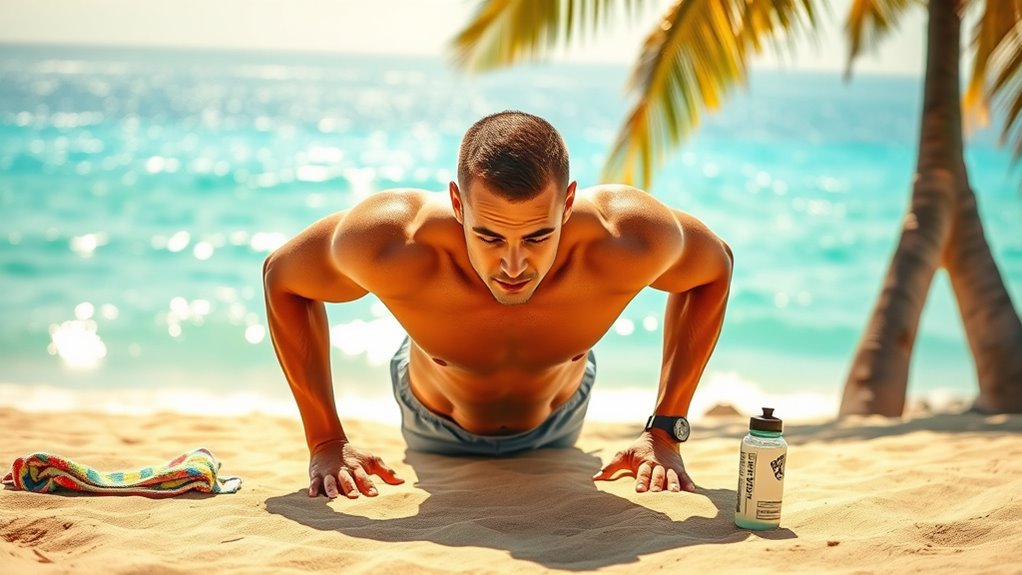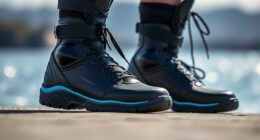For an effective beach training session, focus on bodyweight exercises like planks, squats, lunges, push-ups, and bicycle crunches. Incorporate dynamic warm-up stretches beforehand to prepare your muscles, and follow with cool-down stretches to prevent soreness. These exercises build strength, stability, and endurance without any equipment. By consistently practicing these moves, you’ll improve your overall fitness and beach performance. Keep going to discover how to optimize your routine and stay injury-free.
Key Takeaways
- Incorporate bodyweight squats and lunges to strengthen legs and glutes for beach sports and activities.
- Use push-ups and shoulder taps to build upper body power essential for paddleboarding and beach volleyball.
- Perform plank variations like side planks and plank jacks to enhance core stability and balance on sandy surfaces.
- Include mountain climbers and high knees for cardio and core engagement during outdoor beach workouts.
- Focus on proper form and consistency to maximize strength gains and prevent injuries in your beach training routine.
Warm-Up Stretches to Kickstart Your Beach Workout
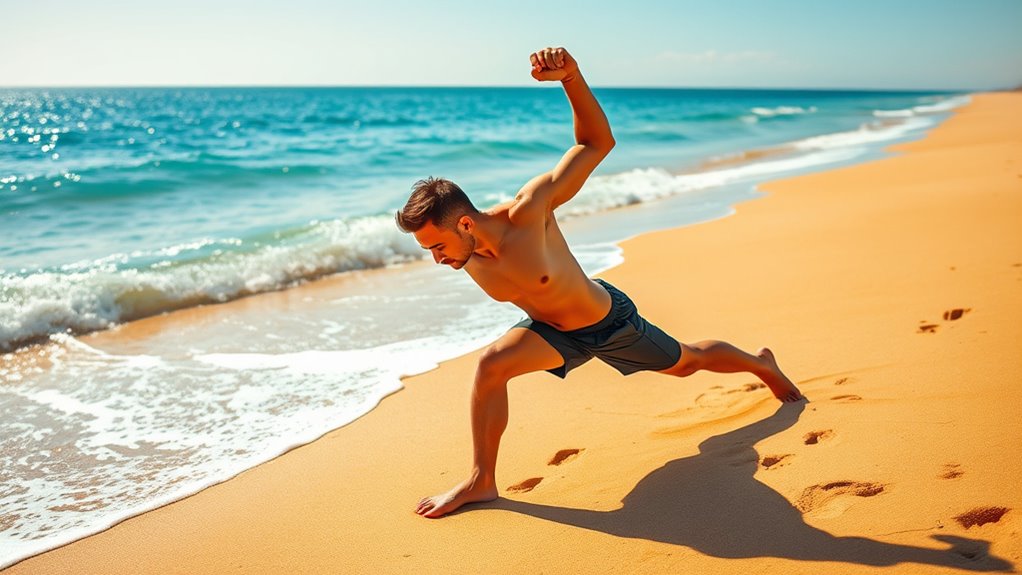
Before diving into your beach workout, warming up with some dynamic stretches is vital. These movements prepare your muscles and joints for activity, reducing injury risk and boosting performance. Start with leg swings—forward and side to side—to loosen up your hips and hamstrings. Follow with arm circles to activate your shoulders and upper back. Incorporate torso twists to engage your core and improve spinal mobility. Jumping jacks or high knees are excellent for elevating your heart rate and increasing blood flow. Keep your movements controlled and fluid, focusing on proper technique. This quick routine gets your body ready for bodyweight exercises, ensuring you stay safe and energized throughout your beach session. Warming up sets a strong foundation for effective training. Additionally, understanding high refresh rates can help you optimize your workout viewing experience.
Perfect Plank Variations for Core Stability
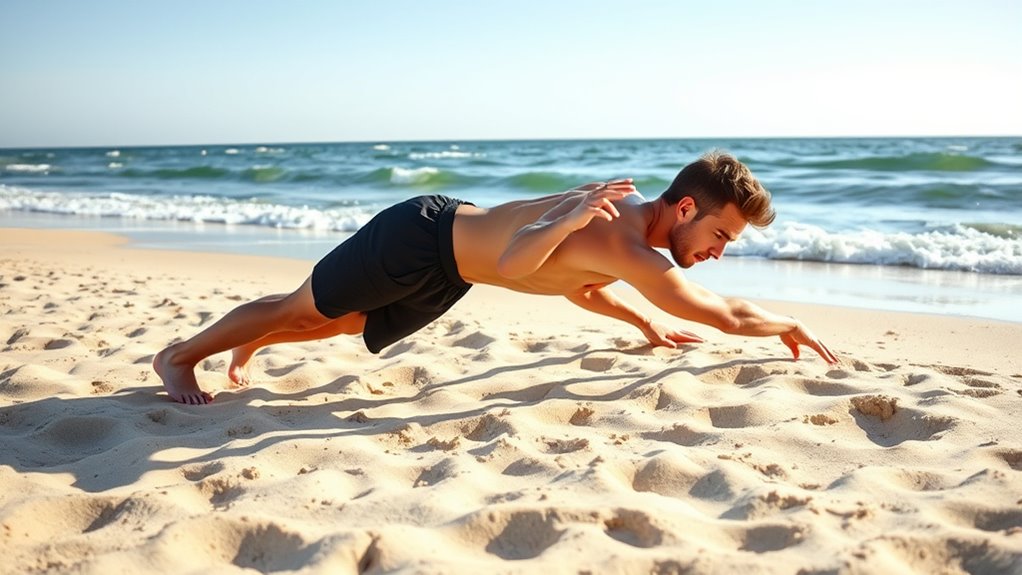
The standard plank is a great way to build a strong core, but adding variations keeps your muscles challenged. Advanced plank challenges push your stability even further, helping you improve balance and endurance. Exploring these options guarantees your core stays engaged and ready for beach workouts. Incorporating core stability techniques into your fitness routine can also motivate you to stay consistent and enjoy your training sessions. For dog owners, incorporating training consistency can enhance overall fitness and motivation during workouts. Additionally, maintaining proper posture and alignment during exercises can prevent injuries and maximize effectiveness, especially when using supportive equipment like specialized core exercise tools.
Standard Plank Benefits
Standard planks are one of the most effective bodyweight exercises for building core stability, as they engage multiple muscle groups simultaneously. By holding a plank position, you activate your abdominals, back, shoulders, and glutes, creating a solid foundation for overall strength. This exercise improves posture by strengthening the muscles that support your spine. It also enhances balance and coordination, which are essential for beach activities like surfing or volleyball. Regularly practicing planks can increase endurance in your core muscles, making daily movements easier and reducing injury risk. Plus, they require no equipment and can be done anywhere, making them perfect for your beach training routine. Incorporating different plank variations can target various muscle groups and prevent workout boredom. Developing a resilient core can improve your overall athletic performance and help prevent injuries during active beach pursuits.
Advanced Plank Challenges
To elevate your core stability training, incorporating advanced plank variations challenges your muscles in new ways and enhances overall strength. These challenges push your limits, requiring greater balance, coordination, and control. Try side planks with leg lifts or forearm to hand progressions for increased difficulty. Incorporate movements like plank jacks or shoulder taps to engage different muscle groups. These variations not only boost core endurance but also improve your overall stability, which translates to better performance during beach activities. Additionally, understanding core engagement can help optimize your workout effectiveness. Engaging the 16PF traits helps tailor exercises to your personality for better motivation and consistency. This awareness aligns with the science of sound healing, which underscores the importance of intentional focus and vibrational energy in achieving physical and mental harmony. Here’s a quick comparison:
| Exercise | Focus Area |
|---|---|
| Side Plank with Leg Lift | Lateral core, glutes |
| Plank with Shoulder Tap | Shoulder stability, obliques |
| Forearm to Hand Plank | Upper body, core activation |
| Plank Jack | Cardio, transverse abdominis |
Adding these challenges will sharpen your core for beach-ready confidence. Exploring bodyweight exercises can further enhance your training routine for outdoor and beach settings.
Bodyweight Squats for Toning Legs and Glutes

Bodyweight squats are an effective way to sculpt your legs and glutes without any equipment. By engaging multiple muscles at once, you’ll build strength and definition in your lower body. To start, stand with your feet shoulder-width apart, toes slightly pointed out. Keep your chest up and core tight as you bend your knees and hips, lowering your body as if sitting back into a chair. Go down until your thighs are parallel to the ground, then push through your heels to stand back up. Focus on controlled movements and proper form to maximize toning. Incorporate squats into your beach workout routine a few times a week, gradually increasing reps to challenge your muscles. Consistency will help you achieve toned, sculpted legs and a firm glute appearance.
Lunges to Build Strength and Balance

Mastering proper lunge technique makes sure you target the right muscles and prevent injury. Trying different variations adds challenge and keeps your workout fresh. Lunges also improve your stability, making everyday movements easier and more balanced. Incorporating proper form in exercises ensures safety and maximizes benefits during your training. Paying attention to authenticity in movement can further enhance your performance and prevent common mistakes. Additionally, maintaining sustainable weight loss strategies can support your overall fitness goals and prevent injury during training. Recognizing the importance of water-based activities can help diversify your workout routine and promote recovery. Monitoring market trends and insights can help you stay motivated and adapt your workout routines to new fitness challenges.
Proper Lunge Technique
Performing lunges with proper technique is essential for building strength and improving balance during beach workouts. Start by standing upright with your feet hip-width apart. Step forward with one foot, lowering your hips until both knees are bent at about 90 degrees. Keep your front knee directly above your ankle, not pushed past your toes, and your back knee hovering just above the ground. Engage your core to maintain stability, and keep your torso upright throughout the movement. Proper form guarantees you target the right muscles safely while preventing injury, making your beach training more effective. Push through your heel to return to the starting position, then repeat with the other leg. Focus on controlled movements, avoiding any rushing. Incorporating data analytics can help track your progress and optimize your workout routine over time. Additionally, understanding hackathons can inspire innovative ways to develop new training techniques or fitness apps that enhance your progress tracking. Staying informed about training safety guidelines ensures you exercise effectively without risking injury. Incorporating nutritional knowledge about hydration and recovery can further improve your training results.
Variations for Challenge
Once you’ve mastered the proper lunge technique, you can challenge yourself further by trying variations that boost strength and improve balance. These modifications target different muscles and increase difficulty, making your workout more effective. Here are some options:
| Variation | Focus |
|---|---|
| Jump Lunges | Explosive power and cardio |
| Walking Lunges | Endurance and coordination |
| Reverse Lunges | Balance and stability |
For example, jump lunges add a plyometric element, forcing you to stabilize quickly. Walking lunges engage your core and improve coordination as you move forward. Reverse lunges emphasize control, helping to develop balance. Incorporating exercise variations like these can significantly enhance your training results.
Benefits for Stability
Lunges are a highly effective exercise for building stability because they engage multiple muscle groups simultaneously, including your core, hips, and legs. This engagement forces you to maintain balance throughout each movement, improving coordination and proprioception. As you step forward or backward, your stabilizer muscles kick in to keep your body steady, which enhances overall balance. Regularly performing lunges helps strengthen your hips, ankles, and knees, reducing the risk of falls and injuries. Plus, they challenge your core to stay engaged, boosting your posture and preventing sway. Over time, this increased stability translates to better performance in other activities, from running to sports. Lunges aren’t just about muscle; they’re a holistic move that enhances your body’s control and equilibrium.
Push-Ups for Upper Body Power

Push-ups are one of the most effective bodyweight exercises for building upper body strength, especially when you’re training at the beach. They target your chest, shoulders, triceps, and core, helping you develop power and endurance. To maximize benefits, keep your body straight from head to heels and lower yourself until your chest nearly touches the ground. Push through your palms to straighten your arms and return to the starting position. Variations like wide-grip or diamond push-ups can emphasize different muscle groups. Doing these regularly boosts your pushing strength, which translates to better performance in activities like paddleboarding or beach volleyball. Plus, push-ups require no equipment, making them perfect for outdoor training sessions. Incorporate them into your routine to build upper body power effectively and efficiently.
Mountain Climbers for Cardio and Core Engagement

Mountain climbers get your heart pumping quickly while targeting your abs. They’re a great way to boost your cardio and strengthen your core at the same time. Keep moving steadily to see maximum benefits on the beach.
Boosts Heart Rate
Since it elevates your heart rate quickly, mountain climbers are an effective way to combine cardio with core engagement during beach workouts. They increase your cardiovascular effort while targeting multiple muscle groups. To maximize their benefits, focus on these key points:
- Maintain a steady pace to keep your heart rate high throughout the exercise.
- Keep your core tight to support your back and enhance calorie burn.
- Use controlled, explosive movements to push your limits without losing form.
- Incorporate sets with minimal rest to sustain elevated heart rates and boost endurance.
Engages Abdominal Muscles
Because mountain climbers require you to bring your knees toward your chest rapidly, they effectively target your abdominal muscles. As you switch legs quickly, your core stabilizes your body, engaging your entire midsection. This movement not only works your rectus abdominis but also activates your obliques and transverse abdominis, helping to sculpt a stronger core. The fast-paced nature of mountain climbers challenges your endurance and forces your abs to work continuously. You’ll feel the burn in your abdominal muscles as they stabilize your hips and spine throughout the exercise. Incorporating mountain climbers into your beach workout boosts core strength and improves overall stability, which is essential for maintaining proper form during other exercises and enhancing your athletic performance.
Tricep Dips Using Beach Equipment or Edges
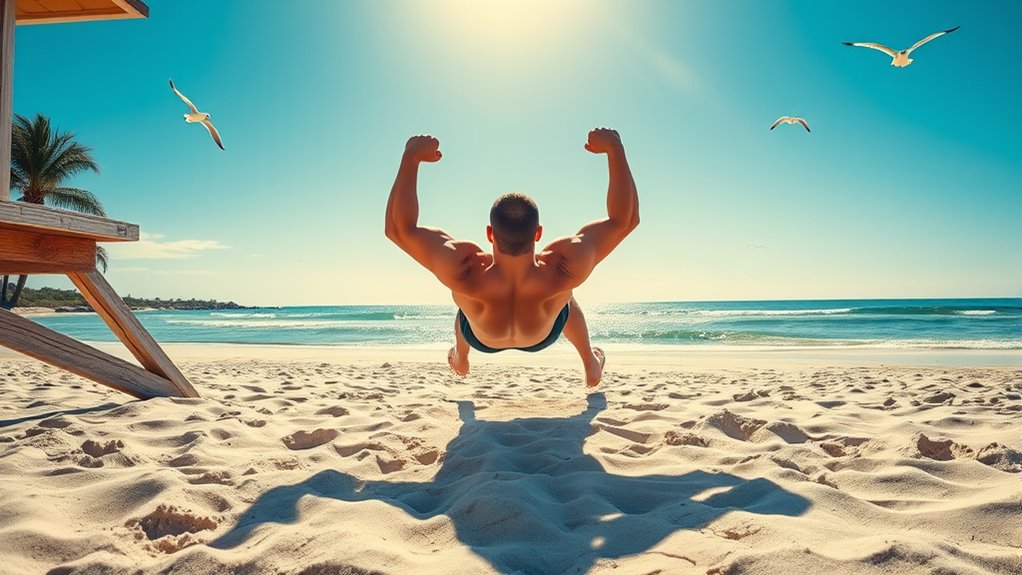
Tricep dips using beach equipment or edges are an effective way to target your arm muscles while enjoying the seaside environment. You can perform these dips on sturdy benches, rocks, or even beach chairs. Here’s how to maximize your workout:
- Find a stable surface about waist-height.
- Place your hands shoulder-width apart on the edge.
- Keep your arms straight as you lower your body.
- Bend your elbows to 90 degrees, then push back up.
This exercise intensifies your triceps and helps build upper body strength. Keep your core engaged to prevent sagging, and control your movements for maximum effectiveness. It’s simple, equipment-light, and perfect for beach workouts. Plus, the ocean breeze makes every rep more invigorating.
Bicycle Crunches for Oblique and Abdominal Definition

Have you ever wondered how to sculpt your obliques and abs simultaneously? Bicycle crunches are a fantastic move to target both areas effectively. Lie on your back, hands behind your head, and lift your legs with knees bent. As you bring your right elbow toward your left knee, straighten your right leg, then switch sides by bringing your left elbow toward your right knee. Keep a steady, controlled pace to maximize engagement. This movement not only works your rectus abdominis but also activates your obliques with each twist. Focus on full range of motion and avoid pulling on your neck. Incorporate bicycle crunches into your beach workout to carve out defined abs and obliques, making your midsection more sculpted and beach-ready.
Leg Raises to Target Lower Abs

Leg raises are a highly effective exercise for targeting your lower abs and building core strength. To maximize benefits, focus on proper form and controlled movements. Here’s how to get started:
- Lie flat on your back with your hands by your sides or under your hips for support.
- Keep your legs straight and lift them towards the ceiling, engaging your lower abs.
- Lower your legs slowly without letting them touch the ground, maintaining tension.
- Repeat the movement for 10-15 reps, ensuring controlled execution throughout.
This exercise intensifies the lower abdominal workout, helping you develop a toned midsection. Consistent practice improves core stability, enhances posture, and boosts overall beach confidence. Remember, quality over quantity is key.
Cool-Down Stretches to Prevent Soreness
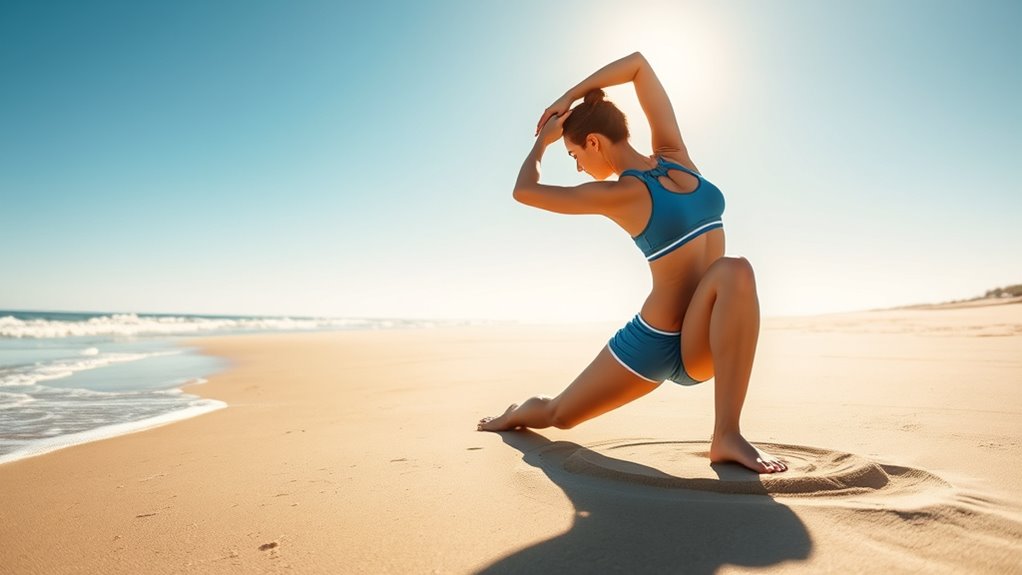
After completing your core workout with leg raises, taking time to cool down with stretches helps your muscles recover and reduces soreness. Focus on gentle stretches that target your lower back, hamstrings, and hip flexors. For your hamstrings, sit on the ground and reach for your toes, keeping your back straight. Stretch your hip flexors by kneeling on one knee and pushing your hips forward. Don’t forget to include a gentle spinal twist to release tension in your back. Hold each stretch for 20-30 seconds, breathing deeply. Cooling down helps prevent stiffness and promotes better flexibility. Make these stretches a regular part of your beach training routine to ensure quicker recovery and reduce the risk of injury.
Frequently Asked Questions
Can Bodyweight Exercises Replace Gym Workouts for Beach Training?
You might wonder if bodyweight exercises can replace gym workouts for beach training. While they can be highly effective, they might not target every muscle group as intensively as weights do. However, with consistent effort, bodyweight routines improve strength, endurance, and flexibility, making them a convenient, versatile option for beach workouts. To maximize results, combine different exercises and challenge yourself as you progress.
How Often Should I Perform These Exercises for Optimal Results?
Think of your workout routine as tending a garden—you need consistent care for blooms of strength to flourish. For ideal results, aim for three to five sessions a week, balancing effort and recovery. You’re building a sturdy fortress of muscle and endurance, so don’t let your efforts wane. Stick with this rhythm, and you’ll see your progress grow like a well-watered plant, vibrant and resilient under the sun.
Are There Any Safety Precautions Specific to Beach Workouts?
When doing beach workouts, safety is key. You should wear appropriate footwear to avoid slipping on wet surfaces, stay hydrated, and apply sunscreen to protect your skin. Be mindful of your surroundings to prevent injuries from uneven ground or sharp objects. Warm up properly before exercising and listen to your body—if you feel pain or extreme fatigue, stop and rest. These precautions help you enjoy your workout safely and effectively.
Can Beginners Effectively Do These Exercises Without Injuries?
You can definitely do these exercises safely as a beginner by listening to your body, starting slow, and focusing on proper form. Before jumping in, warm up thoroughly, stay hydrated, and avoid overexertion. If anything hurts, stop immediately. Building strength gradually and practicing consistency helps prevent injuries. Remember, patience and attention to your body’s signals are key to making progress safely and effectively.
What Equipment, if Any, Is Needed for Beach Bodyweight Exercises?
For beach bodyweight exercises, you typically don’t need much equipment. Just bring a towel or mat to provide comfort on the sand. If you want extra support, consider using resistance bands or a small set of dumbbells. However, most exercises can be done with just your body weight. Focus on proper form, and enjoy the outdoor environment to boost your workout’s effectiveness and enjoyment.
Conclusion
Now that you’ve nailed these nifty, natural bodyweight moves, you’re all set to sculpt and strengthen on the sandy shore. With consistent commitment and a bit of beachside bravado, you’ll build balance, boost your body, and bask in the bliss of beach training. So, seize the sunshine, stay strong, and let your beach workout be your best adventure yet—because progress is just a plank, push-up, and lunge away!

